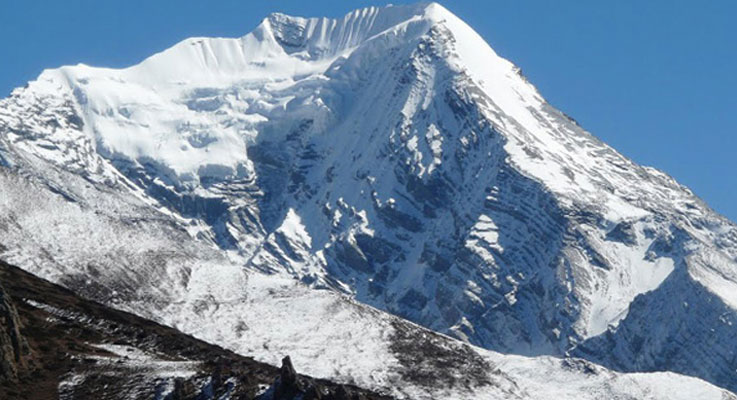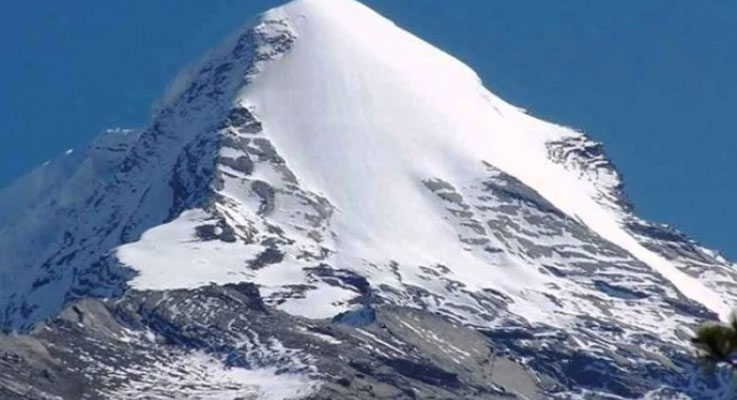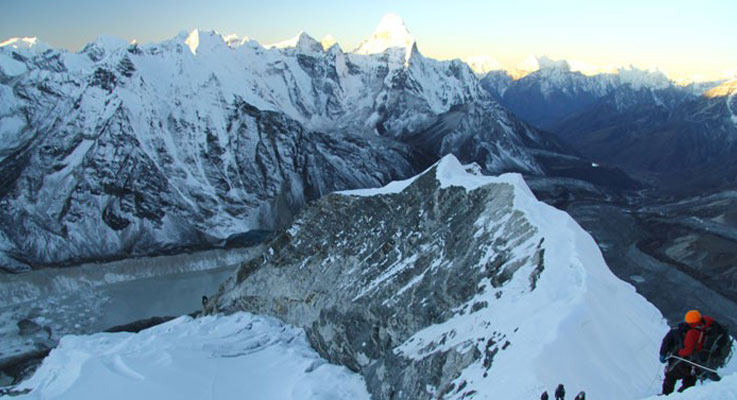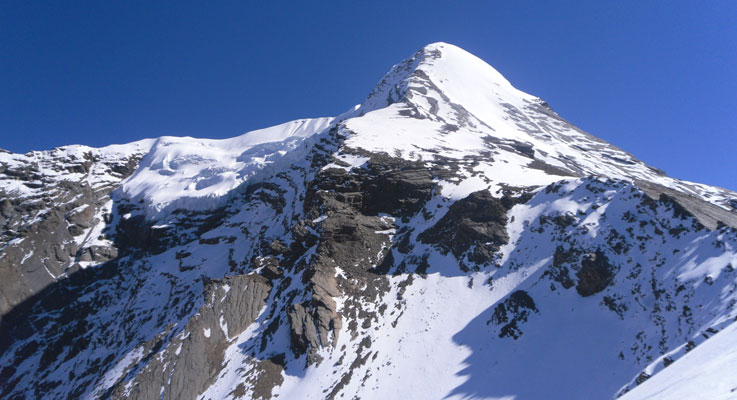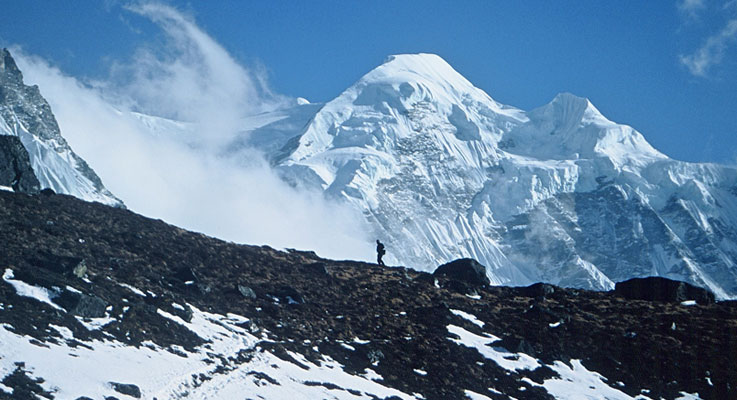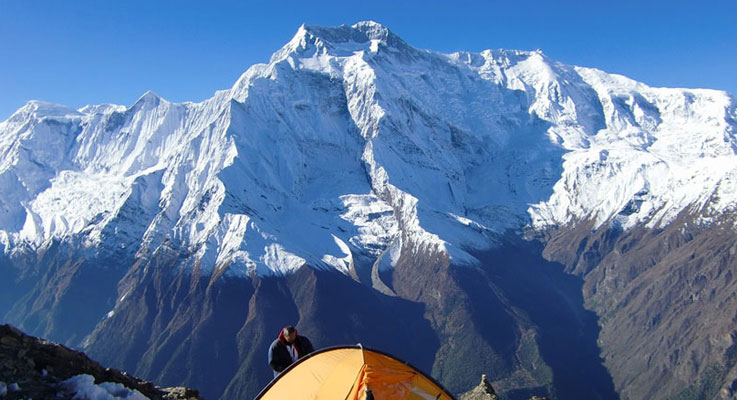-
Day 1
Arrival in Kathmandu (1,345m/4,413 ft)
Upon arriving at Tribhuwan International Airport in Kathmandu, you will be received by our airport representatives who will warmly greet you and transfer to the hotel on a private tourist vehicle. We provide 3-star accommodation in the city and we arrange for a trip briefing with dinner in the evening.
-
Day 2
Visit old town of Kathmandu
A professional guide and vehicle are provided for a day of sightseeing in and around Kathmandu city. We visit some of the UNESCO World Heritage Sites in the city along with other interesting cultural monuments that dot the valley. These include Boudhanath Stupa (the largest Buddhist shrines in the world), Pashupatinath (the holiest Hindu temple in the world), Durbar Squares (Palaces and fortresses of medieval Kings), along with other popular cultural attractions. We get to observe the lifestyle of Nepalese people, holy sadhus and monks, fascinating history as well as awe-inspiring architecture.
-
Day 3
Drive to Besisahar (830m/2,723 ft) and trek to Khudi (780m / 2,559ft)
Our staff will arrive at your hotel at 7am in the morning to pick you up for a 7-hour (185 kms) drive from Kathmandu to the small but bustling town of Besi Sahar. Once at Besisahar, you can witness the stunning snow-capped mountain panorama. We prepare for our trekking that will start from the following day. We take the gravelled road to Khudi for our start of the trek.
-
Day 4
Trek from Khudi to Syange (1,211m / 3,973ft)
There are good views of Himchuli and Manaslu as we descend to the Nadi Khola and then cross the Musi Khola on a suspension bridge and begin long ascent to Bahundanda (1310m). There are excellent views of the Marasyandi Valley ahead from the top of the hill. Cross the river to its west bank more to Syange (1190m). About 7-8 hours walk with one long ascent.
-
Day 5
Trek from Syange to Tal (1,700m / 5,577ft)
We walk through forest to the settlements of Jagat and Chamje (1430m) then we cross the Marsyandi to the east bank. Walking up though forests, we reach the board flat grassy valley of Tal (1075m) and enter into the district of Mustang. Tal resembles a 'Wild West' town with its many painted wooden verandahs. 6 hours walk, ascending for most of the day.
-
Day 6
Trek from Tal to Koto (2,650m / 8,694ft)
Leaving the valley on a rocky path close up against the valley wall, we descend to cross the Marsyangdi yet again reach the village of Dharapani (1930m) Continuing through we pass waterfalls to reach the police check post at Kuparkodo. There are wonderful views of Annapurna and Langtang from this point. We camp in the fields just before entering the village. About 6 hours walk gradually uphill all day.
-
Day 7
Trek from Koto to Pisang (3,300m / 10,827ft)
A short walk from Kuparkodo brings us to Chame (2630m), the administrative center for the Manang area. Continue to walk through pine forest crossing the river once again to reach the settlement of Tibetan Khampas before the village of Pisang.
-
Day 8
Trek from Pisang to Pisang Peak Base Camp (4,380m / 14,370ft)
The trail passes through a narrow forest and meadows to reach the base camp (4180m). Approximately 5 hours hike.
-
Day 9
Trek from Base Camp to High Camp (5,400m / 17,717ft)
Climb up to the High camp, Approximately 5 hours. Preparation for summit the next day
-
Day 10
Reach Pisang Peak summit (6,091m / 19,987ft)
Summit Pisang Peak at 6,091m. The last leg is on a steep and snowy slope, a good effort but without noticeable difficulties. Breath-taking views of Lamjung Himal and Annapurna II and IV. Return to Base camp. Approximately 9 hours.
-
Day 11
Trek from Base Camp to Manang (3,540m / 11,614ft)
Approximately 5 hours hike from the base camp to Manang at 3530m.
-
Day 12
Manang acclimatization day
A day free to rest and acclimatize. There is an opportunity to visit the monastery at Braga, which is reputedly 800 years old, and the village of Manang. The inhabitants of Manang are mainly Gurung who practice Buddhism and dress in a Tibetan style. The flat-roofed houses are closely grouped together in this high arid area. Here we have superb views to the south of Annapurna II and IV, Glacier Dome and the glacial lake below the village formed by water from Gangapurna and Annapurna.
-
Day 13
Trek from Manang to Leder (4,230m / 13,878ft)
Leaving Manang we trek mostly above the tree line. From here there is a gradual ascent to Yak Kharka (4090m) to camp. The surrounding area is used mostly for grazing horses and yaks, but there are quite often herds of 'blue sheep' nearby. We will have time in the afternoon for an excursion from camp in search of local wildlife. About 4 1/2 hours walk.
-
Day 14
Trek from Leder to Phedi (4,450m / 14,600ft)
After breaking camp we cross the Jargeng Khola on a wooden bridge (4,265m). Cross the remains of an old, rocky landslide to reach our campsite at Phedi (4,400m) an open, rocky, flat area beside the river and our base for the crossing of the Thorung La the next day. There will be an acclimatization walk towards the pass during the afternoon. 5 to 6 hours of steady ascent.
-
Day 15
Trek from Phedi to Muktinath (3,760m / 12,336ft)
Ascent, sometimes over loose rocks, to reach a rocky pass marked with the gradient and after several false summits, the Thorung La (pass) finally comes into view marked by two large cairns with prayer flags flying (5416m). The views from the top are simply stunning. We make a long, steep, descent to Muktinath (3800m) and camp in a field in the village. The ascent can take 3 1/2 hours or longer and the descent from 2 1/2 to 4 hours. Muktinath is a village situated close to the Thorung La pass. It is also an important pilgrimage site for both Hindus and Buddhists. We'll spend some time here relaxing and participating in some leisurely explorations of the village, visiting the gompa which houses the 'water that burns'. Hindus believe that bathing here gives salvation after death and it is an important site for many including the 'Bho Tiya' people who inhabit the valley of Muktinath. They are also known as the 'Baraga Ule' or 'people of the 12 villages'.
-
Day 16
Trek from Muktinath to Jomsom (2,720m / 8,924ft)
In the early afternoon we will descend through Jarkot with its impressive fortress to Kingar and Kagbeni (2810m). Kagbeni is like an oasis on this arid area with orchards and fields of barley along the banks of the Kali Gandaki. We are rewarded with good views of Dhaulagiri during our descent. From Kagbeni we turn south for Jomsom (2713m) in the Kali Gandaki valley with the peak of Dhaulagiri directly in front of us.
-
Day 17
Morning flight to Pokhara (900m/2,953 ft)
A short flight takes us to Pokhara from Jomsom. Once in Pokhara, we’ll tour around Pokhara valley, covering Fewa Lake, Devi’s Waterfall, a museum, a Tibetan refugee settlement, Gupteshower Cave, and more. The placid Fewa Lake is the highlight of Pokhara, as are the crystal clear mountains seen from the lakeside and nearby hills.
-
Day 18
Free day at Pokhara
This is a free day at Pokhara for relaxation and reflection of the wonderful trip we’ll have successfully completed. It is also a contingency day in case of flight cancellation to Pokhara. In the lakeside city, there is a ton of amazing activities you could try including paragliding, microlight and zipliner among others.
-
Day 19
Fly from Pokhara to Kathmandu (1,345m/4,413 ft). Free day at Kathmandu
A short and scenic flight from Pokhara gets us to Kathmandu where we can spend some leisure time and take rest. You are free to go souvenir shopping, spa and more exploration of the city, or extend your trip to include bungee jumping, rafting, mountain biking, Everest mountain flight and other adventurous activities. In the evening, we will have a farewell dinner at Mul Chowk Restaurant’s cozy and elegant dining ambience.
-
Day 20
Departure from Nepal
The trip concludes today. You will be dropped at Kathmandu's Tribhuwan International Airport by our airport representative for your flight departure from Nepal.

